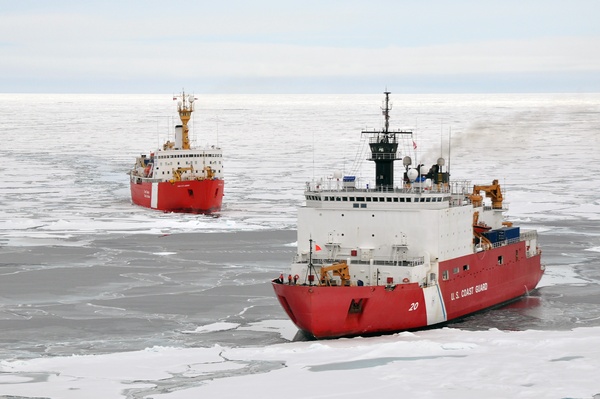
The CCGS Louis S. St-Laurent (left) conducts seismic surveys following the USCGC Healy icebreaker.
In the Arctic, ship-based surveys were used to collect data over vast distances (thousands of kilometres). The field season for ship-based surveys in the Arctic is limited to August – September. Even in this window, ice conditions can present challenges. Researchers conduct bathymetric surveys to measure the depth of water and identify the underwater topography (the shape of the ocean floor or seabed), as well as seismic research to identify the thickness of the sedimentary layer.
For operational and scientific reasons, it is highly advantageous to work with other Arctic Ocean coastal states in the collection and interpretation of scientific data. To date, there has been extensive joint survey work.
Joint surveys for data collection with the US were completed in the Arctic in 2008, 2009, 2010 and 2011 using an icebreaker from each country - the CCGS Louis S. St-Laurent and the US Coast Guard Cutter Healy.
Having these ships and their crews work together ensured a higher quality of data and access to areas that may not have been accessible by a single ship due to the thick sea ice. The Louis broke the ice and cleared a path ahead of the Healy as it collected multibeam bathymetric data, and the Healy broke the ice for the Louis as it collected seismic data. Canada and the US also collected a joint survey off Nova Scotia in 2012.
“To go it alone is either impossible, extremely impractical, or just plain dangerous. While the Louis S. St-Laurent acquires seismic data, we have gear streaming out of the stern of the vessel. We can't use very many propeller revs or the centre shaft for risk of damaging the gear in the water. Also, we can't go backwards if we get stuck in ice. Not a very good situation for an ice breaker. But with the US Coast Guard Cutter Healy breaking ice for us, they clear the path and we get excellent quality data.”
- David Mosher, Chief Scientist, Natural Resources Canada, 2010
Living and Working on an Icebreaker
“Living and working on a ship in the Arctic can be both rewarding and challenging. It gives you an opportunity to work in a place few have the chance to, and it leaves you with an experience that you’ll remember for a lifetime… the differences between land and sea can turn life’s everyday activities into challenges. Every task must be performed with a little extra thought and care.”
- Walta-Anne Rainey, Scientific Technical Support, Natural Resources Canada, 2010
Meet the CCGS Louis S. St-Laurent
CCGS Louis S. St Laurent

Current location of the CCGS Louis S. St Laurent:
https://www.vesselfinder.com/vessels/LOUIS-S-ST-LAURENT-IMO-6705937-MMSI-316165000
